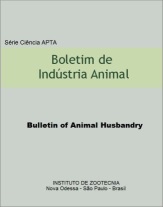PASTURE MANAGEMENT STRATEGIES BASED ON FORAGE OFFER ALTER THE STRUCTURE OF XARAES PALISADEGRASS
DOI:
https://doi.org/10.17523/bia.v74n3p221Keywords:
bulk density, plant height, specific leaf area, stem, grazing intensity.Abstract
Forage offers can be used as a pasture management strategy that considers both the plant and the animal. Therefore, the objective of this study was to evaluate the pre- and postgrazing structure of Brachiaria brizantha cv. Xaraes pastures managed by offering forage at 4, 7, 10 and 13 kg dry matter (DM)/100 kg body weight (BW). The pastures were managed under mob stocking of Holstein cows, with one day of grazing and 21 days of rest. Pre-grazing height increased with forage offer. An increase in post-grazing heights was observed at 13 kg DM/100 kg BW. Pre-grazing leaf and stem percentage or leaf:stem ratio was not influenced by forage offer, but there was a quadratic effect on post-grazing leaf percentage and a linear effect on post-grazing stem percentage. Considering that an increase in forage offer increased post-grazing forage mass and stem percentage, the use of forage at 7 and 10 kg DM/100 kg BW is indicated.Downloads
Downloads
Published
Issue
Section
License
Os autores não serão remunerados pela publicação de trabalhos, pois devem abrir mão de seus direitos autorais em favor deste periódico. Por outro lado, os autores ficam autorizados a publicar seus artigos, simultaneamente, em repositórios da instituição de sua origem, desde que citada a fonte da publicação original seja Boletim de Indústria Animal. A revista se reserva o direito de efetuar, nos originais, alterações de ordem normativa, ortográfica e gramatical, com vistas a manter o padrão culto da língua e a credibilidade do veículo. Respeitará, no entanto, o estilo de escrever dos autores. Alterações, correções ou sugestões de ordem conceitual serão encaminhadas aos autores, quando necessário. Nesses casos, os artigos, depois de adequados, deverão ser submetidos a nova apreciação. As opiniões emitidas pelos autores dos artigos são de sua exclusiva responsabilidade. Todo o conteúdo deste periódico, exceto onde está identificado, está licenciado sob a Licença Creative Commons Attribution (CC-BY-NC). A condição BY implica que os licenciados podem copiar, distribuir, exibir e executar a obra e fazer trabalhos derivados com base em que só se dão o autor ou licenciante os créditos na forma especificada por estes. A cláusula NC significa que os licenciados podem copiar, distribuir, exibir e executar a obra e fazer trabalhos derivados com base apenas para fins não comerciais.













